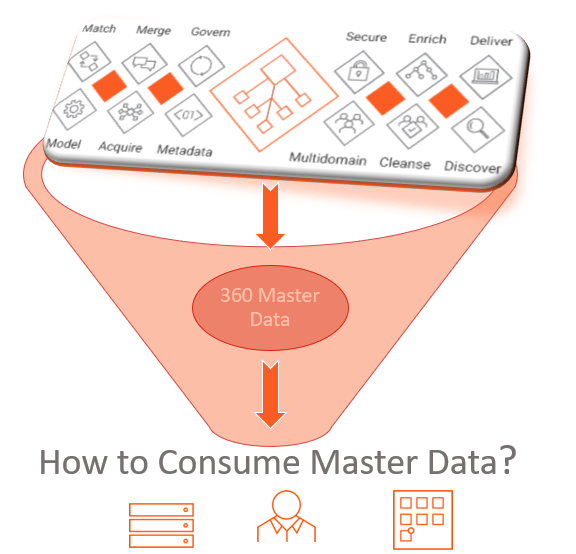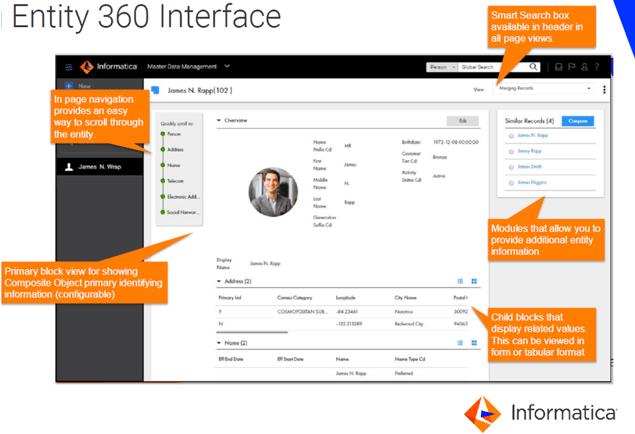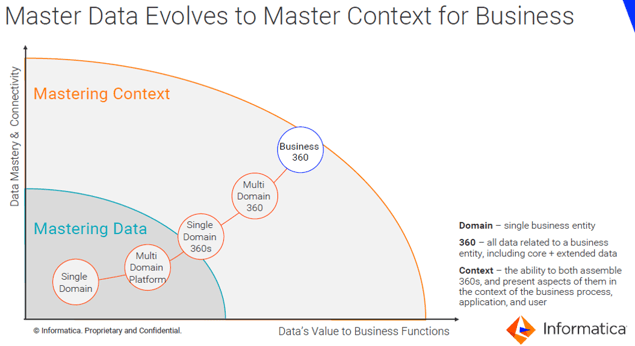
Master Data Consumption & Utilization
A great inventor, Thomas A. Edison once said ‘The value of an idea lies in the using of it’. Close to a century later, this great quote accurately describes today’s master data world. Embarking on the Master Data journey and producing master data are just a couple of small steps in the digital transformation program of an organization but finding accurate ways to consume master data and deriving tangible benefits that contribute to organizational goals can be tricky sometimes.
Often, the MDM team gets bombarded with questions like
·
What are my returns from Master Data?
·
What does Master Data do to our business strategy?
·
How does master data help to make better business decisions?
·
Do we understand our customers better using master data?

Image Source: https://www.informatica.com/products/master-data-management.html
Some of the problems MDM programs often run into when the master data is not consumed are:
- Yet Another Data Silo: Without proper plan and design for functional integration of MDM system with other systems/applications and consumption of the master data, the MDM system runs the risk of becoming ‘just another silo’ with a dump of data in it, requiring babysitting and maintenance. In the worst-case scenarios and without a proper curator, it can even become a Wrathchild that no one wants.
- Loss of meaning: When master data becomes data at rest and no source system/business process consume, utilize, or synchronize their data with the MDM system, the master data loses its business context since the golden record is obtained by consolidating records from disparate source systems.
- Misalignment with enterprise data initiatives: Master Data Management program is an enterprise initiative, as are other data management activities such as data quality, management, and data governance. All of these organizational data initiatives must be coordinated so they can make feed off each other. When the master data is not flowing into these initiatives, the MDM program kind of becomes a misfit with enterprise data initiatives.
Ways to Consume Master Data:
Needless to say that consumption of master data is as critically important as creating it in any master data program. Enterprise applications and business processes must also be designed in such a way that they can consume, synchronize, process, and put master data to the best use possible.
Let’s look into the options provided by Informatica MDM solution to consume, distribute the master data and how the functional integration can be achieved with external applications and business processes.
- Queries and Packages: This is the simplest way to get access to the master data in MDM. The packages created in MDM show up as traditional DB views in the database schema, which can be accessed by the external application without much haggling.
- Message Queues: Informatica MDM has the ability to publish event-based (Create, Update, Delete, Match, Merge, Unmerge, etc.) XML messages to an outbound JMS (Java Messaging System) message queue. External applications can subscribe to these queues and poll them to retrieve the published messages. The process is asynchronous and near-real-time.
- Services Integration Framework (SIF): Services Integration Framework (SIF) is the part of Informatica MDM solution that interfaces with external programs and applications to implement the request/response interactions. SIF facilitates inbound and outbound integration with external applications and data sources, which can be used in both synchronous and asynchronous modes. SIF provides APIs for various MDM Hub services, such as reading, cleansing, matching, inserting, and updating records.
Typical Use Cases for Services Integration Framework (SIF):
SIF requests can be used to develop any of the following sample applications:
- Web services to perform operations in the MDM Hub.
- Business Process Modeling (BPM) and workflow integration by using the Java API or SOAP directly.
- A Java Swing UI to query, view, and edit data in the MDM Hub.
- Server components in a J2EE application server to get and update data in the MDM Hub. Enterprise JavaBeans (EJB) can seamlessly integrate with the MDM Hub transactions.
Entity 360 (E360) Framework: This uses business entity models to support customizable record view layouts and provides a very interactive, informative user interface for managing the master data. The business entity models can be created in Provisioning Tool with an Operational Reference Store (ORS) defined in the MDM Hub. Some of the key features of the E360 framework are:
- Use of Integrated Business Entity Services (BES) to perform a set of operations that run MDM Hub code to create, update, delete, and search for records in a business entity.
- Configurable User Interface that can contain standard and custom components, such as a Twitter, Facebook, Maps feed. Business analysts can easily create layouts targeted at specific user roles.
- Unlimited nesting of descendant records.
- Ability to merge child records that weren’t possible with subject area-based applications.
- Simplified, quick, and enhanced data search; additionally the ability to use ElasticSearch to perform the data search even faster.
A sample customized Entity 360 user interface with some of the key features are shown in the image below:

Image Source: https://success.informatica.com/
Business Entity Services (BES): A business entity service is a set of operations that run MDM Hub code to create, update, delete, and search for base object records in a business entity. Custom user interfaces that can run Java code or JavaScript code can be developed to make business entity service calls. Business entity services are available as web services through Swagger REST API (Swagger implementation is being used from version 10.4 onwards) and SOAP interfaces. E360 & BES together form the building blocks for MDM UIs of the future as the UI, services, and underlying MDM ORSs are all tied together.
Upsides to Your Organization When Master Data is Consumed and Utilized:
When organizations take the right steps and implement a robust MDM program with proper attention to the consumption, distribution of master data, and functional integration of external systems with MDM, they can reap numerous benefits from the MDM program right off the bat and get faster ROI. Some are listed below:
- Realize the ‘concept of 360’: The organizations will be able to realize the concept of 360 across their domains i.e., having a complete, holistic view of any business entities that matter to them, namely individuals, organizations, products, suppliers, location, etc.
- Evolve Master Data to Master Context: With all sources and business processes functionally integrated to consume, synchronize, and process master data, the organization can traverse the path of evolution of master data program to master Context to make their MDM journey a matured one. Context is the ability to both assemble 360s and present aspects of them in the context of the business processes, applications, and users. Below is a quick view of how a master data program can evolve and mature.

Image Source: https://success.informatica.com/
- Confident Business Decisions Driven by Trusted Data & Accelerated Growth: When applications and business processes across the enterprise are in sync and using the same trusted, business-critical master data, all teams, and units can work in cohesion to make informed, strategic business decisions confidently which can catapult organization’s growth.
- Decreased Time to Market: Lines of businesses across an organization can customize products as per their customers’ needs when they know their customers in and out. They also need to factor-in their supply-chain, location, and availability of a multitude of other entities to get these new products to market. Master data can relate and bring all these attributes together to provide a 360-degree view enabling the teams to roll out the new products in no time.
Conclusion:
Master data consumption and utilization have high stakes in any MDM implementation, may potentially even decide the program’s fate. Organizations can only see value in an MDM program only if the enterprise applications, business processes tap into master data’s potential and harness it to deliver consistently.

Posted by PDI Marketing Team
Pacific Data Integrators Offers Unique Data Solutions Leveraging AI/ML, Large Language Models (Open AI: GPT-4, Meta: Llama2, Databricks: Dolly), Cloud, Data Management and Analytics Technologies, Helping Leading Organizations Solve Their Critical Business Challenges, Drive Data Driven Insights, Improve Decision-Making, and Achieve Business Objectives.




